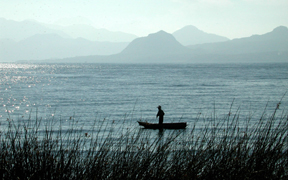 |
|||||||||||||
Winter 2004Jan. 29, 2004
|
|||||||||||||
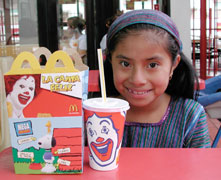 |
Happiness is a Big Mac |
The first couple of weeks here felt like a continuation of last year’s trip. After landing at the crack of dawn at the Guatemala City airport I took a bus directly to the city of Quetzaltenango (Xela) where my adopted family now lives—four godchildren, their older brother, Rolando, and their parents. I discovered most of the family was still in their home village for the holidays, San Antonio Palopó on the shore of Lake Atitlan. The two boys, Winston and Rolando, were left in Xela to handle the family’s sidewalk sales stand.
Xela is high enough in the mountains that the mornings are often frosty; the nights are chilly, and the occasional cloudy days are pretty cold. One of the reasons I come to Central America is to escape that kind of thing—if it wasn’t for the family being there I probably wouldn’t stay in Xela very much. It is a decent city, but not exactly a vacation hotspot.
I spent as much quality time as I could with Winston and Rolando, then after a week or so I came down to the lakeside tourist-dominated town of Panajachel to warm up and visit some friends.
I’ve been coming to Pana since the mid-80s, and every year it gets tamer and more civilized. Once a hot spot for hippies on the “gringo trail” traveling through Latin America, now it is a destination for package tours. Tourists clutching guidebooks wander around with a vague air of bewilderment, as if they aren’t quite sure where they are. They rely on their guidebooks to not only tell them where they are, but where to stay and which restaurants to eat in.
I find myself in an odd position—most of those bewildered tourists are about my age, but they obviously have a better budget than I do. Most of the backpackers traveling on a budget similar to mine are about half my age. I don’t have a lot in common with either group. I don’t know whether to feel smug and worldly wise that I still have what it takes to stay in cheap hotels and jump on chicken buses with the locals, or embarrassed that I don’t have much choice.
I’ll admit, my budget is a lot better than it used to be; the places I usually stay these days are in the $4-$5 range, rather than the $2-a-night flea-bag joints I used to seek out. And when I eat beans and tortillas now it is because I want to, not because I have to. But still, when I see the tourists come to town in their big-window buses and wander around with their funny hats and white legs I know I’m on a whole different trip.
More Mitsubishi Madness
Several times I have written about the Mitsubishi mini-van Don Pablo, the patriarch of my adopted family, bought a few years ago. It was in pretty bad shape when he bought it, and it deteriorated after that. One evening, when it looked like we were going to get it running and on the road, Don Pablo pulled out a scenic calendar of Guatemala. He wistfully pointed to pictures of places he would like to visit. His eyesight was failing badly at the time and even if we had been able to go anywhere he would not have been able to see much. But touring Guatemala was part of the dream he had for the mini-van. I think I really hurt his feelings when I told him it was a worthless pile of junk and I never wanted to drive it again, but after the first outing we had after we got it running I was overcome by my own feelings.
When Don Pablo died, about a year and a half ago, I thought the Mitsubishi was history. (Ironically Don Pablo died in the Mitsubishi, on his way to a hospital. If I were dying that is not the vehicle I would want to find myself in being rushed to a hospital. But it is possible that is exactly where he wanted to be.) Last year I left Guatemala with the understanding that the mini-van had been put to rest. I would have thought it more likely that Don Pablo would be resurrected than the Mitsubishi. But, like Frankenstein’s monster, IT’S ALIVE!
The first I heard of it was in connection to a trip to some Mayan ruins near the city of Huehuetenango. When I was in Pana I went out to San Antonio for a quick visit to the rest of the family—the aunts, cousins, etc. Two of the aunts, 17-year-old Luisa and the elder sister, Petrona, from whom Faye and I rent a room when we stay in the village, asked me whether I would be interested in seeing the ruins. I’m not a big fan of Mayan ruins, but I had never heard of them, and had never been to Huehue (“WHEY whey”—place names here are often such a mouthful that the “tenango” is dropped.)
For years Petrona has talked about me going across the border into Mexico with her, just to show her the ropes of a border crossing, but nothing ever came of it. Like most Mayan villagers she works hard, and recreational trips are pretty rare. So I figured I’d play along with the idea of going to the ruins. “Sure,” I said. “Why not?”
Petrona looked at me with a sly smile and said “We could take the Mitsubishi.” She jokes quite a lot, so I just said, “Yeah, right.”
“No really, it’s running! We could all go in it,” she said. I finally realized with horror that she was serious.
So we did the trip—Luisa and Petrona, me, four of the kids—and a driver named José.
I guess they figured, correctly, that I was not about to drive the Mitsubishi. (Rumor has it that José is the boyfriend of Alva, the aunt that is in law school in Xela. And that they have a baby. Neither Alva nor José have let on that either rumor is true.)
In all fairness the Mitsubishi performed pretty well on the trip to Huehue. It is still so feeble that, I swear, it slows down when it turns north. And it needs a muffler, not only to make it quieter but to route the exhaust fumes away from the passenger compartment. But we made it with no mishaps. José is a good driver, uncharacteristically cautious for a Guatemalan.
The ruins were pretty dull. There were several small pyramids which had been “restored” by the United Fruit Company during its heyday in the 50s. The pyramids had been excavated and plastered over with concrete. They probably looked more like they actually did when they were in use by the Mayas, but they might as well have been modern reproductions.
Run for the Border
After the trip to the ruins I guess Petrona figured that the trip to Mexico was a real possibility this year. I told her I was up for it if she was. We made plans for her and Luisa to meet the kids and I in Xela the following weekend. Nothing was said about the Mitsubishi, but I wasn’t completely surprised when they pulled up in it—José driving. (Neither was I surprised when they showed up five hours late.)
The border was about three hours away. When we got there we didn’t really know what to expect as far as getting the Guatemalans and the Mitsubishi across. I knew I would have no trouble. José parked the Mitsubishi and we went to the Guatemalan border station. We learned getting out of Guatemala was not going to be a problem—just pay the proper fee, get some papers stamped, and adiós. I got the exit stamp on my passport and we walked across a bridge to the Mexican border station.
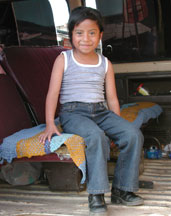 |
Sarita waits to cross the border to Mexico |
On the window of the office of the border official there was a notice in big letters saying that minors must be accompanied by a parent. I figured we might as well turn around and go back. José explained the situation to the official, and the official told him just what the notice said. José explained a bit more (I didn’t catch all he was saying) and the official reached through the little hole in his window and tapped the notice and said something like “Can’t you read the sign?” This went on for a while longer, then we left and started walking back towards where the mini-van was parked.
“That’s too bad,” I said. “The kids are going to be really disappointed.”
José said, “I’m going to go get the car and drive across and see what happens.” I thought I had a pretty good idea what would happen, considering the conversation with the Mexican border official. But I figured we had nothing to lose by trying. I explained to José that I couldn’t go back and forth across the Guatemalan border since I already had an exit stamp in my passport. I told him I would stay on the bridge until we knew whether they would get across.
So I waited in the no-man’s land between the two countries. It was a little like being in limbo, strangely peaceful. I had left Guatemala, but had not yet entered Mexico. To entertain myself while I waited I pondered what complications might arise if I lost my passport at that point. Then I thought about what if an alert Mexican official realized that the Mitsubishi had no business being on the road. That fantasy didn’t last long. That might happen in California, but not Mexico. (In Mexico, if anyone noticed at all, it would just be a matter of paying the proper fee.)
I saw the mini-van clear the Guatemalan station. José stopped on the bridge where I was waiting and Luisa shouted out to me, “Petrona and I have the same last name as the kids. It will be OK.” And it was. One thing you learn down here is whatever anyone says, written or otherwise, it is never the last word.
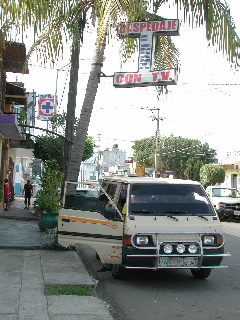 |
The infamous Mitsubishi mini-van outside the hotel in Mexico. |
By the time we got across it was getting on towards evening. Our destination was the city of Tapachula, about an hour from the border. I had been to Tapachula several times, but mostly passing through on a bus. I wasn’t much help guiding José to the plaza in the center of the city, but we eventually found it. It was a Saturday and as usual on Saturday nights in Mexican towns the plaza was crowded and festive. We parked and everyone (but me) got their first taste of Mexico. Folkloric dancers performed on a stage at one end of the plaza, and all over there were food vendors, musicians and street performers. Our enjoyment was tempered by the stifling heat of the coastal lowlands, which we were unaccustomed to. All of us were sweating; I felt sorry for the dancers but they showed no signs of discomfort.
We stayed in the plaza until long after dark. Finally we had had enough and decided it was time to look for a hotel. The hotels near the center of town turned out to be rather pricy, so we started driving around.
We finally found a small hotel on a dark street a couple dozen blocks from the center of town. We took a quick look at the rooms and agreed that they were adequate, and they were in our price range. We took three rooms; José stayed in one by himself, 11-year-old Winston and I stayed in one, and the other four kids and their two aunts took a third room with two beds.
It wasn’t until we had paid and gotten settled we discovered that our hotel offered its customers the convenience of renting rooms by the hour. (The locked cage we had to go through to get to our rooms should have tipped us off, but I just thought that they took security seriously.) Several times during the night I heard the desk clerk knock on a door down the hall and call out “time’s up!”
The three rooms we took comprised half the capacity of the hotel, so we probably put a damper on that kind of business. I can only speculate what affect the sound of children laughing and cartoons on the TV had on the other guests. But I like to think that at least briefly we brought a family atmosphere to the place.
I think everyone, especially the kids, enjoyed our little Mexican adventure, but we were happy to cross back into Guatemala the next day, onto familiar ground. Next year we might try it again. I am hoping I can convince them to go by bus.
__________________________________________So, with those two modest adventures I feel like I entered the middle part of this trip. Faye is flying down to Nicaragua in the middle of February, so I’ll get on a bus and meet her in Managua. Between now and then there are several possibilities as to what I will do. We’ll see what happens.
return to top
March 2, 2004
Panajachel, Guatemala
Nicaragua: There and Back
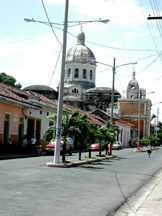 |
Granada street |
A few days after the last entry I decided instead of hanging out in Guatemala another week, not really enough time to go anywhere on my list of places I haven’t been to yet, I would head down to Nicaragua. But once there I felt like I did in Guatemala, that there wasn’t enough time to do much before Faye flew down from Oregon. So I went straight to Granada and spent several days doing little more than roaming the city, socializing with fellow travelers and eating.
Maybe I am rationalizing, but it seems to me that hanging out with fellow travelers is a legitimate travel activity as long as you don’t overdo it. In virtually every region there are known “watering holes” where travelers gather to recover from the rigors of their trip, indulge in some comfort food, and exchange stories and information about other parts of the world. Guidebooks are an important resource, but often even current editions are outdated. The best information is gathered from other travelers who have just come from where you are going, or have recommendations for places to go that you might not have considered. (For example, the hot recommendation this year seems to be South Viet Nam.)
Inevitably conversations turn to comparisons between where you are and where you’ve been. There are lots of best/worst stories involving accommodations, buses, food and illnesses. For most I don’t think Nicaragua will be the best or worst in any of those categories (though one can get pretty sick anywhere…)
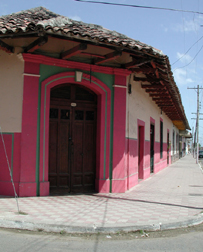 |
Colonial doorway |
Nicaragua is similar to Guatemala in many ways, on the surface at least, but in others it is completely different. Most noticeable is the absence of the Mayas that give Guatemala so much color and character. There were natives related to the Maya in what is now Nicaragua, but they disappeared long ago.
But a more interesting difference is the kind of travelers and tourists who are coming to Nicaragua. For one thing many seem to be coming up from Costa Rica where, from all accounts, things are pretty civilized. While some of them are world travelers, many of them seem a bit wide-eyed and naïve compared to the savvy chicken bus veterans of Guatemala. Some are Costa Rican residents or long-term visitors who have to get out of the country for a few days then re-enter to get a fresh visa stamp. Their visit to Nicaragua is little more than an inconvenient formality.
Then there are the expats, foreigners who have left their own country to live in Nicaragua. There seem to be more dreams and schemes than in Guatemala. The expats of Nicaragua have an air of desperate optimism, like there, at the end of the road, they may finally find the opportunity they have been searching for.
A while back there was a sociology student doing a study of the expatriate community around Lake Atitlan in Guatemala. Someone told him the expats there were the ‘wanted and the unwanted.”
In Nicaragua an American woman who had recently moved to Granada said to me, “You’ve heard the saying that if you can make it in New York, you can make it anywhere? Well, here they say if you can’t make it anywhere else you come to Nicaragua.”
 |
One of Granada's old cathedrals |
Though there is a growing number of foreign retirees and escapees moving to Guatemala, many have been in the country for fifteen or twenty years, and more. Some have raised families. By contrast just about every expat we met in Nicaragua was a recent arrival. Their reasons for coming were fresh in their minds; they hadn’t yet had to contemplate reasons for staying.
Among the get acquainted questions foreigners ask each other in Nicaragua the most common is “Are you buying property here?” The second most common seems to be “Do you have a project?” A lot of people say yes to one or both questions. (A negative answer to both immediately pegs you as no more than a tourist.)
A surprising number of people come to Nicaragua in search of a “project,” an outlet for their charitable urges, perhaps seeking redemption for a life of comfort. Or maybe it looks easier to change this part of the world than the part they came from. Some of them buy school uniforms, book bags and school supplies for hundreds of children at a time. I’m not sure they ever know any of the kid’s names, but they feel like they are doing something good.
For others moving to Nicaragua is a chance to start over, to bury the past or at least try to rewrite it. There are some real characters. Some seem reluctant to give much information about themselves, but others you couldn’t stop them if you tried. Gossip and rumors float freely—if you want to find out about somebody, just ask somebody else.
Some hope Nicaragua will be a place where a paltry fixed income or a savings account that didn’t amount to much back home might be enough to live on. For those who can’t afford Costa Rica, Nicaragua is “Plan B”.
Then there is the “sleaze factor” as someone put it—lonely old white men looking for young brown girls to attend to their needs. Sometimes it turns out to be a costly bargain; whole families come with the deal and it is hard to say who is taking advantage of whom.
I don’t think expats ever actually blend into the culture of their host country (regardless of what some of them think), but in Guatemala the relationship between the expats and the Mayas seems to be more symbiotic, more comfortable somehow. Maybe it is because there are so many fundamental differences that they aren’t really competing for the same resources.
In Nicaragua things seem a little strained. There are certainly important cultural differences between the Nicaraguans and the foreign residents, but the major difference seems to be economic. I asked a Nicaraguan who works in the tourist industry there what the locals thought about the foreigners pouring into the country. He said, “We need the money.” His answer seemed a little evasive. I asked someone else the same question and got a similar response. When there is such a flagrant difference between the “haves” and the “have nots” there will always be resentment, and often escalating problems.
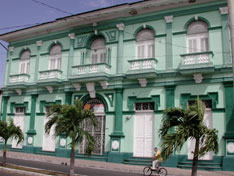 |
For Sale: $400,000 |
In some ways the foreigners coming to Nicaragua seem like a new class of elite. In Granada many are buying old colonial homes and restoring and/or remodeling them. One real estate brochure hinted that some available places were unadvertised because their owners didn’t want their neighbors to know they were selling—it would look like they needed the money.
Frankly, the remodeled places we saw were stunningly beautiful inside and out. It is hard not to think rescuing these crumbling mansions is a good thing in some respects. But they become so expensive that only other foreigners will ever be able to own them. Maybe Nicaraguans in the construction or tourist industries are benefiting, but I am not sure many others are.
Back to the Travelogue
Well, this isn’t much of a travelogue so far. I’ll try to give a brief account of how Faye and I spent our time in Nicaragua.
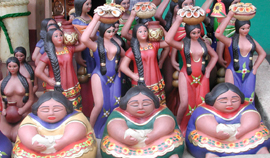 |
Ceramic Beauties |
As I said at the beginning, I arrived in Granada about a week before Faye flew in. After spending a couple nights in a mosquito-infested dive I moved to a pretty nice place where we stayed last year. Then, when Faye arrived we moved to an even nicer place, with a pool, hammocks and free internet. In fact it was so nice that we spent most of the two weeks we were together just hanging out there. (Another couple staying there, evidently also feeling a little guilty about indulging in such luxury, called it a “vacation from our vacation.”)
Faye didn’t feel up to much travel, so we just took a couple day trips to nearby villages, and one visit to Managua, the capitol. Otherwise our explorations were pretty much limited to trying out different restaurants in Granada. We went to a couple art openings and an open house for a new restaurant/hotel, where we brushed shoulders with the “elite” I was just complaining about above.
Then Faye flew back home, and I bused it back up to Guatemala. In keeping with the level of luxury I had become accustomed to surprisingly quickly I booked a passage on the best bus available for the trip, the King Quality line. Amenities included movies on the overhead video screens, air conditioning and an onboard attendant who passed out hot meals, refreshments and, to those overcome by the tedium of first-class travel, pillows and blankets. Even more importantly the attendant handled most of the border crossing formalities, so we didn’t have to stand in line, pushing and shoving among the less fortunate.
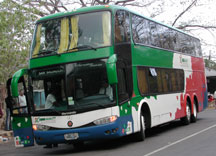 |
The chicken bus alternative |
Back in Guatemala City I took a taxi from the King Quality terminal to where the chicken buses leave for Panajachel. In some ways it felt good to be back in the “real” world, but I did kinda miss the pillows and blankets.
About two weeks are left of this year’s trip. I’ll spend some of it with my little family in Xela, and a few days doing some last minute shopping in Panajachel.
Until next time…… Jimreturn to top
|
|
|
